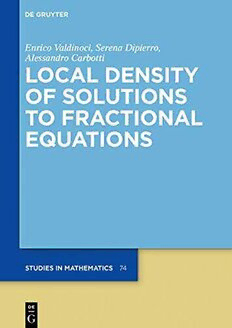
Local Density of Solutions to Fractional Equations (De Gruyter Studies in Mathematics) PDF
Preview Local Density of Solutions to Fractional Equations (De Gruyter Studies in Mathematics)
AlessandroCarbotti,SerenaDipierro,andEnricoValdinoci LocalDensityofSolutionstoFractionalEquations De Gruyter Studies in Mathematics | Editedby CarstenCarstensen,Berlin,Germany GavrilFarkas,Berlin,Germany NicolaFusco,Napoli,Italy FritzGesztesy,Waco,Texas,USA NielsJacob,Swansea,UnitedKingdom ZenghuLi,Beijing,China Karl-HermannNeeb,Erlangen,Germany Volume 74 Alessandro Carbotti, Serena Dipierro, and Enrico Valdinoci Local Density of Solutions to Fractional Equations | MathematicsSubjectClassification2010 Primary:26A33,34A08,35R11;Secondary:60G22 Authors AlessandroCarbotti Prof.Dr.EnricoValdinoci DipartimentodiMatematicaeFisica DepartmentofMathematicsandStatistics UniversitàdelSalento UniversityofWesternAustralia ViaPerArnesano 35StirlingHighway 73100Lecce Crawley,WA6009 Italy Australia [email protected] [email protected] Prof.Dr.SerenaDipierro DepartmentofMathematicsandStatistics UniversityofWesternAustralia 35StirlingHighway Crawley,WA6009 Australia [email protected] ISBN978-3-11-066069-2 e-ISBN(PDF)978-3-11-066435-5 e-ISBN(EPUB)978-3-11-066131-6 ISSN0179-0986 LibraryofCongressControlNumber:2019946148 BibliographicinformationpublishedbytheDeutscheNationalbibliothek TheDeutscheNationalbibliothekliststhispublicationintheDeutscheNationalbibliografie; detailedbibliographicdataareavailableontheInternetathttp://dnb.dnb.de. ©2019WalterdeGruyterGmbH,Berlin/Boston Typesetting:VTeXUAB,Lithuania Printingandbinding:CPIbooksGmbH,Leck www.degruyter.com Preface Thestudyofnonlocaloperatorsoffractionaltypepossessesalongtradition,moti- vatedbothbymathematicalcuriosityandbyreal-worldapplications.Thoughthisline ofresearchpresentssomesimilaritiesandanalogieswiththestudyofoperatorsofin- tegerorder,italsopresentsanumberofremarkabledifferences,oneofthegreatest beingtherecentlydiscoveredphenomenonthatallfunctionsare(locally)fractionally harmonic(uptoasmallerror).Thisfeatureisquitesurprising,sinceitisinsharpcon- trastwiththecaseofclassicalharmonicfunctions,anditrevealsagenuinelynonlocal peculiarity. Moreprecisely,ithasbeenprovedin[25]thatgivenanyCk-functionfinabounded domainΩandgivenanyϵ>0,thereexistsafunctionf whichisfractionallyharmonic ϵ inΩsuchthattheCk-distanceinΩbetweenf andf islessthanϵ. ϵ Interestingly,thiskindofresultscanbealsoappliedatanyscale,asshowninFig- ures1,2,and3.Roughlyspeaking,givenanyfunction,withoutanyspecialgeomet- ricprescription,inagivenboundeddomain(asinFigure1),onecan“complete”the functionoutsidethedomaininsuchawaythattheresultingobjectisfractionallyhar- monic.Thatis,onecanendowthefunctiongivenintheboundeddomainwithanum- berofsuitableoscillationsoutsidethedomaininordertomakeanintegro-differential operatoroffractionaltypevanish.ThisideaisdepictedinFigure2.Asamatteroffact, Figure2mustbeconsideredjusta“qualitative”pictureofthismethod,andshouldnot beregarded“realistic.”However,evenifFigure2doesnotprovideacorrectfractional harmonicextensionofthegivenfunctionoutsidethegivendomain,theresultcanbe repeatedatalargerscale,asinFigure3,addingfurtherremoteoscillationsinorderto obtainafractionalharmonicfunction. Figure1:Allfunctionsarefractionalharmonic,atdifferentscales(scaleoftheoriginalfunction). https://doi.org/10.1515/9783110664355-201 VI | Preface Figure2:Allfunctionsarefractionalharmonic,atdifferentscales(“first”scaleofexterioroscilla- tions). Figure3:Allfunctionsarefractionalharmonic,atdifferentscales(“second”scaleofexterioroscilla- tions). Inthissense,thistypeofresultsreallysaysthatwhatevergraphwedrawonasheet ofpaper,itisfractionallyharmonic(morerigorously,itcanbeshadowedwithanar- bitraryprecisionbyanothergraph,whichcanbeappropriatelycontinuedoutsidethe sheetofpaperinawaywhichmakesitfractionallyharmonic). Thisbookcontainsanewresultinthislineofinvestigation,statingthateveryfunc- tionliesinthekernelofeverylinearequationinvolvingsomefractionaloperator,upto asmallerror.Thatis,anygivenfunctioncanbesmoothlyapproximatedbyfunctions lyinginthekernelofalinearoperatorinvolvingatleastonefractionalcomponent.The settinginwhichthisresultholdsisverygeneral,sinceittakesintoaccountanomalous diffusion,withpossiblefractionalcomponentsinbothspaceandtime.Theoperators takenintoaccountcomprisethecaseofthesumofclassicalandfractionalLaplacians, possiblyofdifferentorders,inthespacevariables,andclassicalorfractionalderiva- tivesinthetimevariables.Namely,theequationcanbeofanyorder,itdoesnotneed anystructure(itneedsnoellipticityorparabolicityconditions),andthefractionalbe- haviorisintime,space,orboth. Inasense,thistypeofapproximationresultsrevealsthetruepoweroffractional equations,independentlyofthestructural“details”ofthesingleequationundercon- sideration,andshowsthatspace-fractionalandtime-fractionalequationsexhibitava- rietyofsolutionswhichismuchricherandmoreabundantthaninthecaseofclassical diffusion. Preface | VII Though space- and time-fractional diffusions can be seen as related aspects of nonlocal phenomena, they arise in different contexts and present important struc- turaldifferences.Theparadigmaticexampleofspace-fractionaldiffusionisembodied bythefractionalLaplacian,thatis,afractionalrootoftheclassicalLaplaceoperator. Thissettingoftensurfacesfromstochasticprocessespresentingjumpsanditexhibits theclassicalspatialsymmetriessuchasinvarianceundertranslationsandrotations, plusascaleinvarianceoftheintegralkerneldefiningtheoperator.Differentlyfrom this,time-fractionaldiffusionistypicallyrelatedtomemoryeffects,andthereforeit distinguishesverystronglybetweenthe“past”andthe“future,”andthearrowoftime playsamajorrole(inparticular,sincethepastinfluencesthefuture,butnotviceversa, time-fractionaldiffusiondoesnotpossessthesametypeofsymmetriesofthespace- fractionalone).Inthesepages,wewillbeabletoconsideroperatorswhichariseas superpositionsofbothspace-andtime-fractionaldiffusion,possiblytakingintoac- countclassicalderivativesaswell(thecasesofdiffusionwhichisfractionaljustin eitherspaceortimearecomprisedasspecialsituationsofourgeneralframework). Interestingly, we will also consider fractional operators of any order, showing, in a sense,thatsomepropertiesrelatedtofractionaldiffusionpersistalsowhenhigheror- deroperatorscomeintoplay,differentlyfromwhathappensintheclassicalcase,in whichthetheoryavailablefortheLaplacianoperatorpresentssignificantdifferences withrespecttothecaseofpolyharmonicoperators. Toachievetheoriginalresultpresentedhere,wedevelopabroadtheoryofsome fundamentalfactsaboutspace-andtime-fractionalequations.Someoftheseaddi- tionalresultsareknownfromtheliterature,atleastinsomeparticularcases,butsome otherarenewandinterestinginthemselves,and,indevelopingtheseauxiliarythe- ories,thismonographpresentsacompletelyself-containedapproachtoanumberof basicquestions,suchas: – boundarybehaviorforthetime-fractionaleigenfunctions; – boundarybehaviorforthetime-fractionalharmonicfunctions; – Greenrepresentationformulas; – existenceandregularityforthefirsteigenfunctionofthe(possiblyhigherorder) fractionalLaplacian; – boundary asymptotics of the first eigenfunctions of the (possibly higher order) fractionalLaplacian; – boundarybehaviorof(possiblyhigherorder)fractionalharmonicfunctions. Wenowdiveintothetechnicaldetailsofthismatter.
